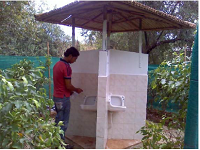/topics/sanitation-and-hygiene
Sanitation and Hygiene
Handbook for flood protection, anti-erosion and river training works by Central Water Commission (2012)
Posted on 13 Feb, 2013 09:43 PMThis handbook by Central Water Commission aims to provide necessary guidance to the field engineers in the state and central for design, appraisal, construction and monitoring of the flood management works covering all the relevant BIS codes, design manuals, guidelines, technical specifications for construction materials and practices etc. to meet new challenges in the flood management in India.
Guidelines on the integrated low cost sanitation scheme by Ministry of Housing and Urban Poverty Alleviation (2012)
Posted on 11 Feb, 2013 05:41 PMThis document by Ministry of Housing and Urban Poverty Alleviation provides guidelines for the low cost sanitation scheme. The main objective of the scheme is to convert the existing dry latrines into low cost flush latrines and to construct new ones.
Analysis of Delhi’s budgetary allocations for water and sanitation services in slum areas - Article in Economic and Political Weekly
Posted on 06 Feb, 2013 11:18 AMThis article in Economic and Political Weekly, by analysing various budget documents, attempts to capture the quantum of budgetary outlay for Water and Sanitation Services (WSS) in the slums of Bawana and Bhalaswa in Delhi. Further it captures various systemic weaknesses that impede the effective delivery of WSS in these two slum areas.
A communication and advocacy strategy framework for sanitation and hygiene, by the Ministry of Drinking Water and Sanitation and UNICEF (2012-17)
Posted on 05 Feb, 2013 08:44 PMThe number people practicing open defecation in India is more than 600 million. Though the access to improved sanitation has increased since 2000 the pace of change has been slow. If the current trend continues then it will be difficult for the country to meet its Millenium Development Goal for sanitation. Thus accelerating access to and use of toilets and hygiene practices have become a national priority.
A toilet that loves the environment: A film by the Himalaya Seva Sangh highlighting Uttarakhand's experience with eco-san toilets
Posted on 03 Feb, 2013 03:43 PM
The Himalayas are inhabited by 40 million people, most of whom are dependent on agriculture and animal husbandry. The prevalent water scarcity also means a lack of water for sanitation. In this case, both open defecation and conventional sewerage pose a health risk. Conventional toilets not only consume a lot of water, but the effluent also pollutes groundwater.
A resource book on waterless urinals, an ecological sanitation method that saves water, energy and uses urine as a resource
Posted on 02 Feb, 2013 05:40 PM
Waterless urinals (WLU) save water, energy and use urine as resource ( Image courtesy: R Sakthivel)
ICLEI South Asia, on behalf of ACCESSanitation India partners, invites tenders for the construction of on-site treatment systems and public convenience complexes in Hosakote, Karnataka and Rajahmundry and Vikarabad, Andhra Pradesh
Posted on 30 Jan, 2013 01:50 PMSealed tenders are invited from experienced and technically qualified contractor shaving previous experience of similar types of works, on item rate basis. The date, time & place for acceptance of tenders is as below.
TISS and UNICEF, Maharashtra jointly offer Post-Graduate diploma in water, sanitation, and hygiene (WASH) - Apply by February 28, 2013
Posted on 28 Jan, 2013 01:17 PMTata Institute of Social Sciences and UNICEF, Maharashtra
About TISS
The Tata Institute of Social Sciences (TISS) was established in 1936, as Sir Dorabji Tata Graduate School of Social Work, a post-graduate school of social work of national stature to meet the emerging need for trained human service professionals.
Centre for Water Policy, Regulation, and Governance, School of Habitat Studies, and School of Rural Development, Tuljapur with UNICEF, Maharashtra jointly offer Post-Graduate Diploma in water, sanitation, and hygiene (WASH)







